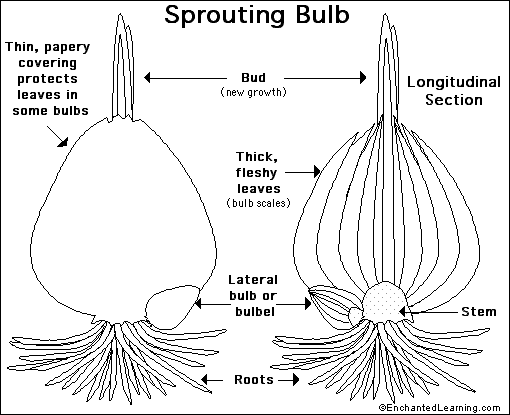 |
| Daffodil Glade at the Morton Arboretum. Daffodils work great in a natural setting mixed with other spring-blooming flowers. |
If you start to notice juncos landing at your front doorstep, then it's probably a wise decision to start planting bulbs into the ground (those little birds are usually a sign that winter is right around the corner). Flower bulbs are a great choice for the garden if you are looking for instant colors in the spring, and fall is the time to plug them into the soil. Many of them are low maintenance, and do not need fertilizer to improve their flowering performance. Popular flower species that arise from bulbs include Tulips (Tulipa), Daffodils (Narcissus), Ornamental onions (Allium), Snowdrops (Galanthus), and Hyacinths (Hyacinthus).
 |
| Anatomy of a Tunicate flower bulb |
Botanically speaking, a bulb is a very compact underground stem. Most of the bulb is made up of swollen, scaly leaves that act as an energy storehouse for the plant. Full of starches and other nutrients, they give the plant a quick boost of growth just as the weather warms up in the spring. In the center of all those scaly leaves is a fully formed plant, flowers and all. There are some plants that are sold under "bulbs" but are different from the textbook definition. For example, Crocuses are defined as a corm which is a modified root rather than a stem. But don't let the confusion hinder you from planting them. Many of these plants grow and flower for only a couple months, and quickly retreat back into the ground for a long slumber.Their origins in mountainous areas where the growing season is short, or in woodlands where sunlight is abundant in spring and fades in the summer months has led to this adaptation. When flowering ends, it is very important to not cut back the leaves when they are still green! They absorb all that energy back into the bulb to survive throughout the rest of the year, and to produce flowers for the next spring. Wait until the foliage turns yellow and brown to cut them back (but you can worry about this when that crucial decision-making process comes in June).
Mid October through early November are the best times to plant bulbs in the Chicago area when the ground is still manageable. Personally, I've had a couple occasions where I procrastinated into December to plant them. They came up great, but it's just too much work to dig into soil caked in frost. When planting, make sure that the point faces up and the flat part of the bulb is firm in the ground. Larger bulbs such as Daffodils and Tulips should be planted about 6"-8" deep into the soil, while smaller Crocuses and Grape Hyacinths should have about 2"-4" deep. This ensures good protection from the elements and from rodents.You can also force some of them inside for added color in you home during the winter. Leave them in the fridge for about a month of two to make them think it's winter, and plant them in a container next to a sunny window.
 |
| Tulips add color to a flower bed before summer annuals are installed |
You can use bulbs in many areas of your yard. Planting Daffodils, Grape Hyacinth, and Chiondoxia in a shaded area adds a more naturalistic look to the area. Use Hyacinths and Tulips as a front border to add color to a perennial bed. You can even throw some Crocus corms in you lawn, and they will flower and fade away before you even think of mowing it!
So plant some flower bulbs in your yard now. You can forget about them through all those winter months, and have some surprising color in your yard when spring returns!
 |
| Dark-eyed Junco, the "Harbinger of Winter." Get those bulbs in before these little sparrows take over your yard! |



+Fall+Color+(6)+-+Copy.JPG)